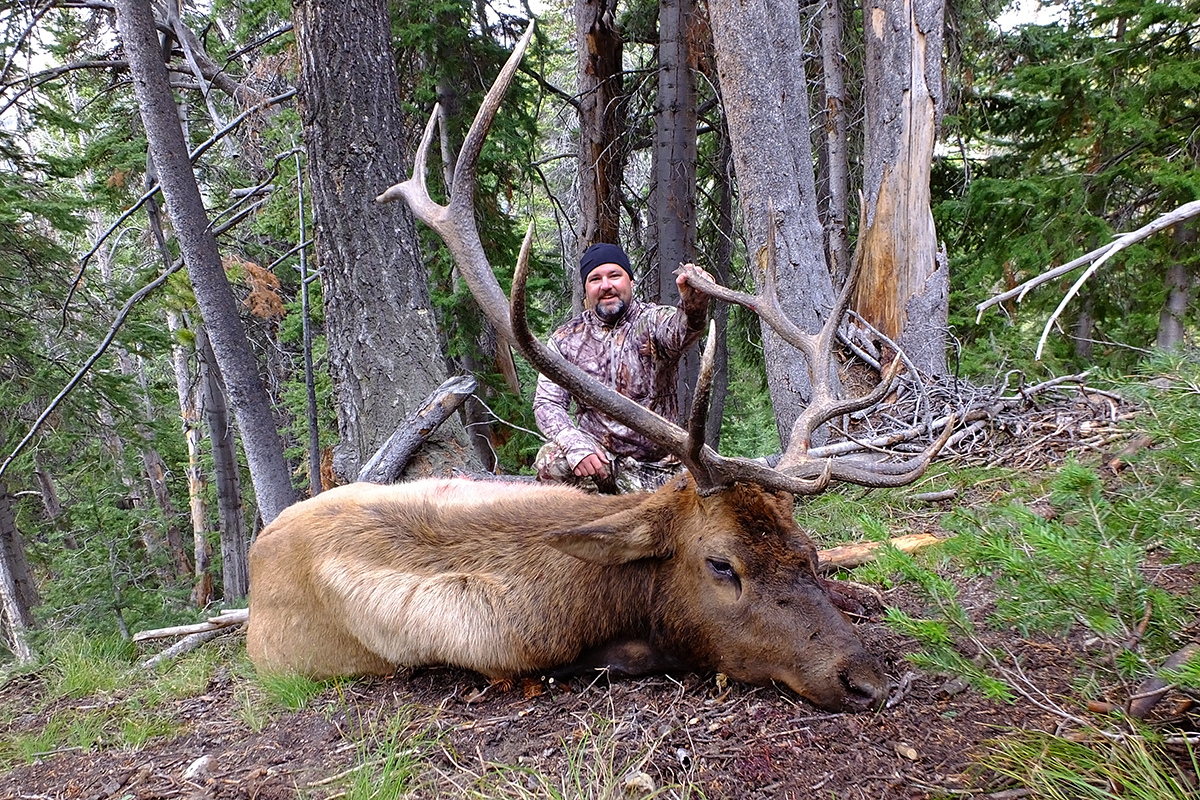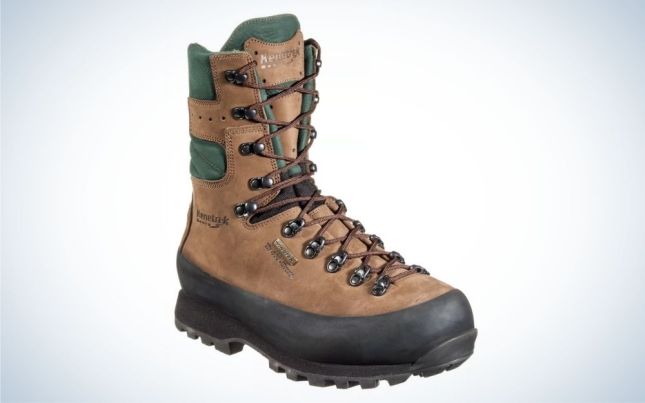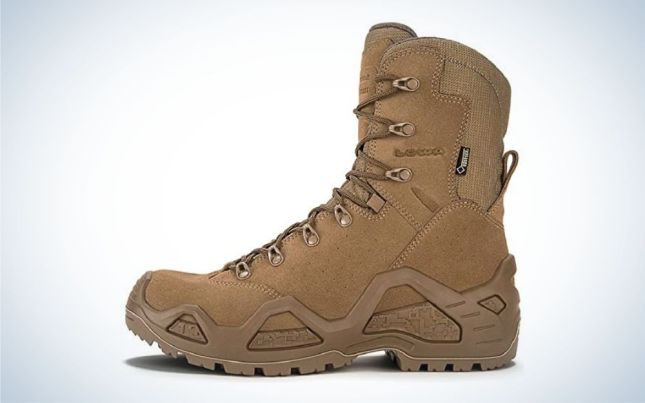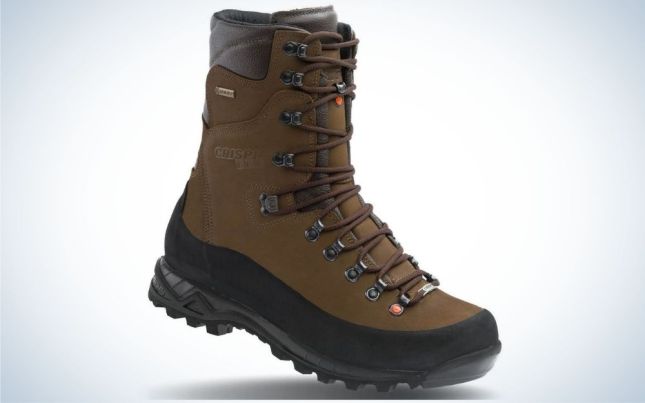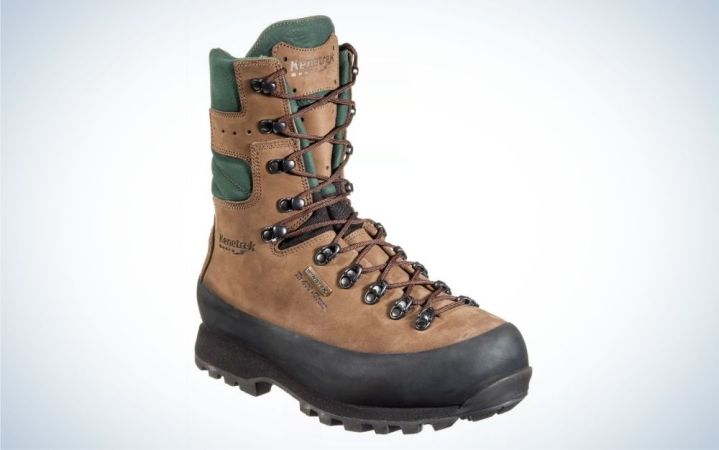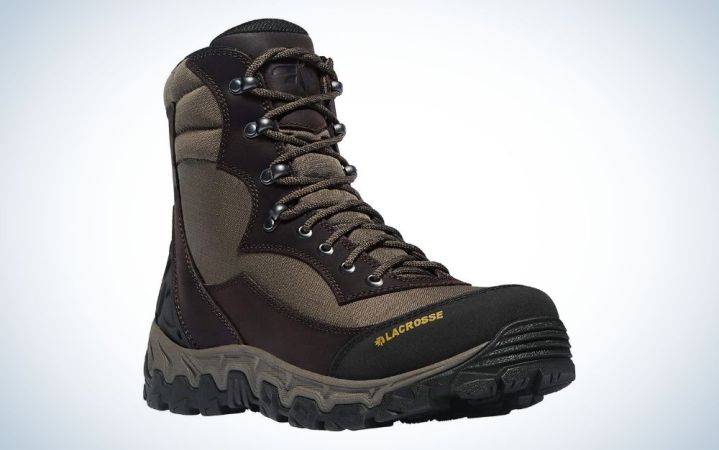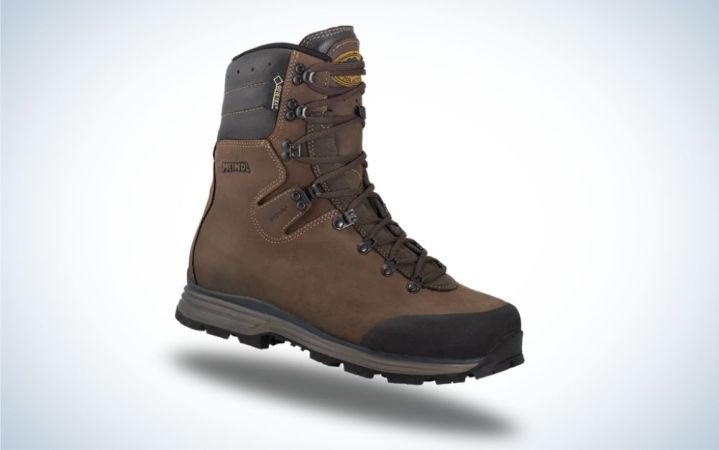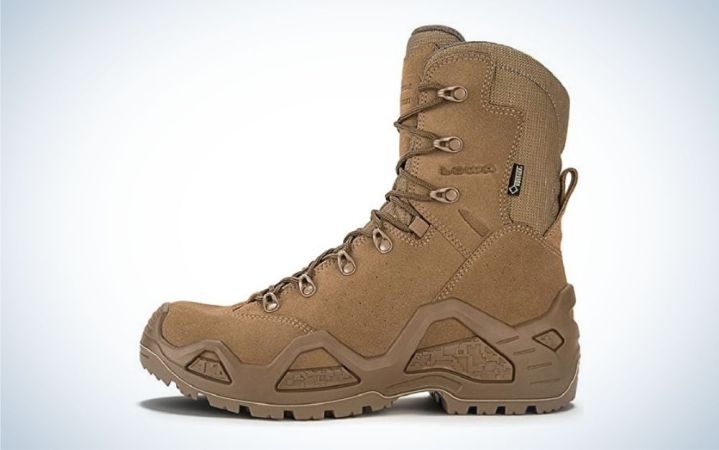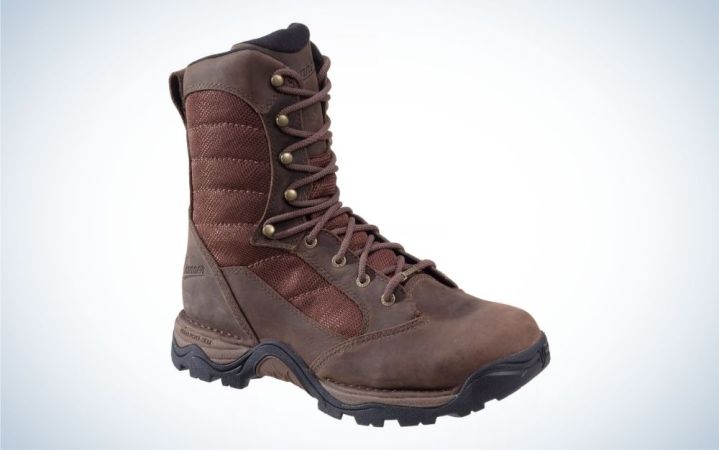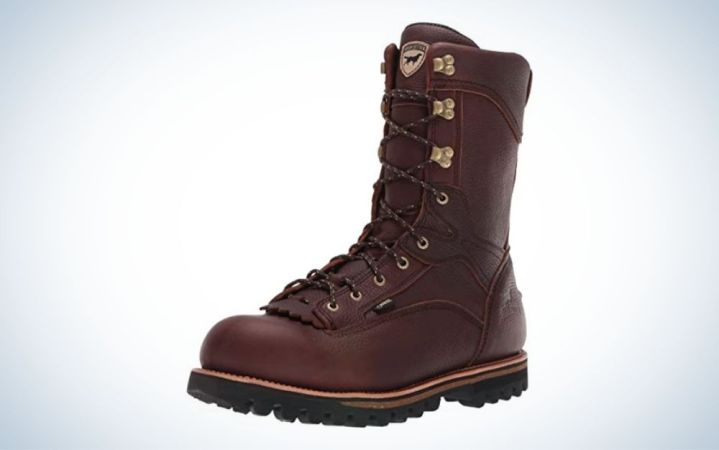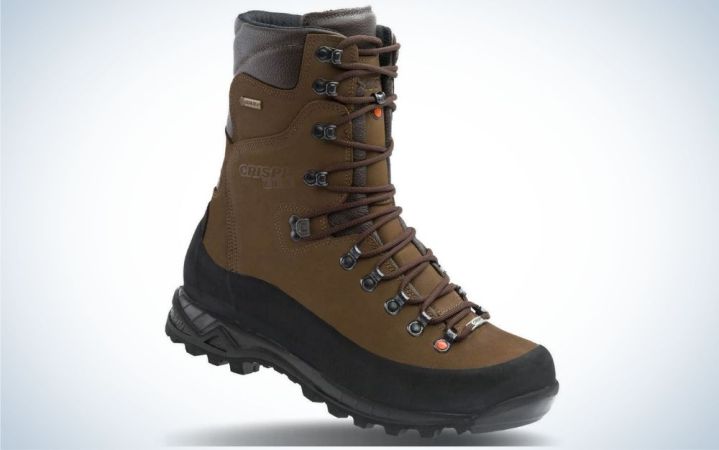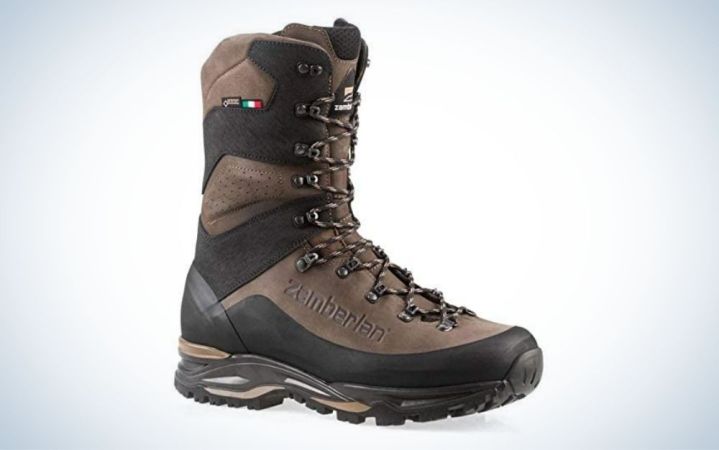We may earn revenue from the products available on this page and participate in affiliate programs. Learn More ›
The hunter with the strongest legs and lungs and solid pair of elk-hunting boots usually wins. That’s the mantra I apply every fall as I migrate off the grid, and do my best to notch my elk tag that I keep buried deep in a specific pouch in my pack. I don’t own horses, mules, or llamas, or favor areas where motorized vehicles can travel. I prefer a DIY approach. But that’s just me.
However, strong legs and lungs can only get you so far if you don’t take care of that all-important necessity that separates your feet from the terrain—reliable elk-hunting boots. Years ago, I coached an athletic hunter into the field on his first hunt. He bought a pair of boots two sizes too large on Craigslist, and after days of wet weather and miles of travel, he stopped working uphill just 50-yards shy of his comfort shooting range. His feet were bloody, blistered, toenail-missing stumps and wrinkled as a prune. Before the next season, he researched and bought better fitting boots that were suited for the elements. And he ended up harvesting his first backcountry mule deer and elk within 48 hours of one another.
The point is twofold—owning a pair of the boots from a highly-regarded manufacturer that doesn’t fit properly will serve you just as well as an inexpensive, poorly-constructed, form-fitted pair. Here’s a quick look at some of the best elk-hunting boots available, along with some notes on how to select a pair that won’t leave your feet barking.
- Best Insulated: Kenetrek Mountain Extreme 400
- Best Early Season: LaCrosse Lodestar
- Best for Archery Hunting: Meindl Comfort Fit Hunter 400
- Best Lightweight: Lowa Z-8S GTX
- Best for Wide Feet: Danner Pronghorn
- Best for Cold Weather: Irish Setter Elk Tracker
- Best for Wet Conditions: Crispi Guide GTX
- Best Heavy Duty: Zamberlan 981 Wasatch GTX RR
How I Tested the Best Elk Hunting Boots
For better or worse, I put a lot of miles on several the best elk hunting boots and brands or styles for a long time, and while I’d like to say trial and error has helped me zero in on a few pairs that are just right for me, I could easily change my mind the next time I slip on something new and different. So, for the purpose of this review, I relied on the good, bad, and ugly. With these boots, I either observed them in the field, personally tested, or interviewed other elk hunters on the ones I’ve never laced up myself.
Best Elk Hunting Boots: Reviews & Recommendations
Best Insulated: Kenetrek Mountain Extreme 400
Best Insulated
Key Features
- Height: 10 inches
- Weight: 4.2 pounds
- Insulation: 400 grams Thinsulate
- Lace Length: 80 inches
Pros
- Tough construction
- Rubber sole guard
- Excellent traction
Cons
- A bit heavy
- Pricey
If you hunt elk, and you haven’t at least tried on a Kenetrek boot, you aren’t doing your homework. Kenetrek makes some of the toughest elk-hunting boots ever made. The Mountain Extremes are a perfect introduction to the Kenetrek lineup. Yes, they are (and feel) a little heavy on the hoof, but in the worst conditions (snow or rough terrain) the ankle support, insulation, and bulletproof materials and construction are well worth it. If you’re worried about the price point, remember many hunters say their Kenetrek boots are the last boots they’ll own, and that’s not an exaggeration with proper care.
Best Early Season: LaCrosse Lodestar
Best Early Season
Key Features
- Height: 7 inches
- Weight: 2.9 pounds
- Insulation: Uninsulated or 400 grams Thinsulate
- Lace Length: 76 inches
Pros
- Gore-Tex breathable liner
- Deep heel cup
- Flexible soles
Cons
- Ankle support lacks compared to other options
- Not great for wet conditions
The Lodestar is a proven, tough boot built to traverse nasty terrain without sacrificing comfort, especially during warm early-season hunts. These are one of the few boots I’ve slipped on that actually fits like it was built for my foot. I’ve had whitetail-hunting boots that fit the same, but not boots designed to traverse steep terrain. LaCrosse says the Lodestar’s deep heel cup and EVA midsole are the reason each pair fits like a glove, and after a few miles, it’s hard to argue this point. But if I had to pick one feature that concerns me, it’s the construction and stitching. This boot is lightweight, so I’d like to see how they hold up to copious backcountry miles.
Best for Archery Hunting: Meindl Comfort Fit Hunter 400
Best for Archery Hunting
Key Features
- Height: 9.25 inches
- Weight: 4.125 pounds
- Insulation: 400 grams
- Lace Length: 84 inches
Pros
- Super-durable laces
- Quality construction
- Well insulated
Cons
- Uncomfortable insoles
- Heel hot spots
Meindl boot materials are resilient (if properly cared for), and the ankle support is more than adequate when you need to leave the trail and get within archery range. For years, my Meindl boots have been my hands-down favorite hunting boot. It doesn’t matter if I’m chasing elk in the mountains, deer in the river bottom, or trekking through thick cover to flush a pheasant—these boots handle it all. But like any footwear, proper maintenance will ensure you get as many miles out of a pair as you can. Fortunately, Meindl makes its own proprietary waterproof and wax treatments and easy-to-follow instructions that make it easy to keep each pair strong and stable, season after season.
Best Lightweight: Lowa Z-8S GTX
Best Lightweight
Key Features
- Height: 8 inches
- Weight: 2.64 pounds
- Insulation: Uninsulated
- Lace Length: 80 inches
Pros
- Lightweight
- Durable
- Solid ankle support
Cons
- Poor traction on wet snow
- Narrow toe box
- Little shock absorption
When I’m not wearing my Meindl boots, I’m wearing my Lowas. During the early archery season or those times when I don’t need insulation, excess weight, or submarine-grade waterproofness, I grab this pair. Whenever I lace up my Lowas, it feels like I’m strapping into a ski boot. They offer terrific support without the added weight. The materials and construction are rock solid, and the tread is perfect for trekking up rocks and mountain scree. And the design wraps and locks my ankles tight, which is perfect for run-and-gun situations when your two legs are trying to close the gap on an animal that has four. That said, think about using aftermarket insoles, athletic tape, and moleskin with these. The tradeoff for traveling fast and light might mean a few hotspots or blisters.
Best for Wide Feet: Danner Pronghorn
Best for Wide Feet
Key Features
- Height: 8 inches
- Weight: 3.3 pounds
- Insulation: 400 grams Primaloft
- Lace Length: 72 inches
Pros
- Breathable Gore-Tex liner
- Full-grain leather upper
- Great arch support
- Reasonable price
Cons
- Traction isn’t the best
- Hard insole
A hunting friend and I wore Danner Pronghorn boots while elk hunting for years, and they never failed. Danner continues to make improvements to their lineup of the best elk hunting boots every year. One of the reasons I like these boots so much is because of the ankle support. Whether intentional or not, my Pronghorns fit a little tight around my feet, but that doesn’t bother me too much because lacing them securely around my ankles means I’m avoiding possible injuries. The other thing the Pronghorns have going for them is they’ve always kept my feet dry and warm in wet conditions—something other boots constructed with similar materials don’t do. While they don’t have the greatest traction, they outperform their price point. And if you’re looking for an affordable elk hunting boot, these are hard to beat.
Best for Cold Weather: Irish Setter Elk Tracker 860
Best for Cold Weather
Key Features
- Height: 12 inches
- Weight: 4.25 pounds
- Insulation: 1,000 grams Thinsulate
- Lace Length: 108 inches
Pros
- Breathable Gore-Tex liner
- Full-grain leather
- Odor-killing liners and footbeds
- Excellent ankle support
- Tons of warmth
Cons
- Heavy
These tall boots won’t just protect and support your ankles, but they’ll keep you warm too. The Elk Trackers are packed with 1,000 grams of insulation, which can make the difference between staying in the field or going home with freezing feet in the late season. Irish Setter’s Elk Tracker lineup has garnered the respect of countless elk hunters, especially those hunting in tough conditions in the Rocky Mountain West.
At a glance, the first thing that sets this pair apart from others is its height. Like some of the best rubber hunting boots, these reach a full twelve inches tall, and there’s enough leather to lock in your ankles, support your lower legs, and protect your bottom calf from all things that can scratch and poke off the trail. But it’s what’s inside the boots that really matters. Loaded with insulation, the Elk Trackers are excellent for cold-weather hunting, and thanks to the Gore-Tex membrane and all-leather construction, your toes will stay warm and dry in rain, snow, or mud.
Best for Wet Conditions: Crispi Guide GTX
Best for Wet Conditions
Key Features
- Height: 10 inches
- Weight: 4.2 pounds
- Insulation: 200 grams
- Lace Length: 84 inches
Pros
- Waterproof
- Air-mesh footbed
- Flexible soles
Cons
- Heavy
These boots have rock-solid ankle support and are impervious to even the harshest and wettest weather conditions. I admit I was a little worried the Crispi GTXs would fit a little too rigid and solid around my foot and ankle, but I was pleasantly surprised by how much give these boots offer and how soft my steps felt on the footbed. The Crispis are the best elk hunting boots for the wettest conditions you’ll encounter. These waterproof boots will keep your feet dry, so you don’t have to worry about them sloshing around in a pool of water, or spending a day at camp while your boots dry. One piece of advice, however—Crispi boots sometimes feel snug, so if you like to wear thick socks for insulation or cushion, consider upping your boots half a size larger.
Best Heavy Duty: Zamberlan 981 Wasatch GTX RR
Best Heavy Duty
Key Features
- Height: 11 inches
- Weight: 3.96 pounds
- Insulation: Uninsulated
- Lace Length: 78 inches
Pros
- Rugged
- Solid ankle support
- Resoleable outsoles
Cons
- Uninsulated for cold weather
- Break-in time was longer than other boots
The hefty outsole, rubber rands, and reinforced construction, make the Wasatch GTX a sturdy and durable elk-hunting boot. I was not able to test the Wasatch in the elements it’s built for. However, if you’re familiar with the brand’s Outfitter series, know this latest iteration features more support, traction, and performance. Given it’s engineered for low-level sheep hunting, that shouldn’t come as a surprise. Zamberlan says the midsoles are slightly stiffer than the Outfitter, but that the Gore-Tex membranes are the same and offer both breathability and water protection. The 11-inch height should assist and protect anyone concerned about lower-leg or ankle injuries. The price range might not fall into many hunter’s budgets, but for some serious hunting in some seriously nasty conditions, it’s worth trying on a pair of the best elk hunting boots for tough terrain, if only for comparison.
Things to Consider Before Buying the Best Elk Hunting Boots
Your personal hunting style, anticipated terrain, and the area’s climate are the most important factors to consider before buying the best hunting boots for elk season. For early season, dry-weather hunts on trails, a flexible and lightweight boot is hard to beat, even if you think you’ll cover a lot of ground. If you prefer to travel off the beaten path, opt for more ankle support and less flex underfoot to give your feet support on uneven terrain.
Insulation
If you’re hunting during the early archery season, you might not need to concern yourself with waterproofness or boot insulation as much as you might want to account for it during the late season when you’re more likely to encounter rain, snow, and mud. And while insulation is characteristically lightweight, it will add some weight. This might not seem like a big deal if you do a lot of spot and stalking, but it can turn into a tiresome issue if your route from A to B is especially long, and you need to make it there in a short time.
Break-in Period
Also, new boots shouldn’t feel like new boots when you head out. Take time to gradually break in any pair to avoid foot sores. Three things that help with those are quality socks, moleskin or athletic tape, and boot laces. Good socks mended with superior materials, like merino wool, will serve your feet bar better than bargain bin package deals. It still takes time for your feet and boots to form around one another, and that’s where moleskin and tape come in handy. Apply them on hot spots or potential blisters before they start. Finally, lacing your boots differently can make a big difference in your comfort level while you’re traveling. You can relace, pull, and tighten your laces to gain more tension across your instep, cinch the upper boot around your ankles, or even take pressure off your toes.
Read Next: The Best Hunting Boots of 2023
FAQs
Like my bloody-toed, elk-hunting friend at the beginning of this story, there are countless other hunters that have experienced similar miserable outings because they weren’t properly fitted for the boot they’re wearing, or they failed to break them in. You can avoid the same circumstance by preparing well in advance of your hunt—give yourself plenty of time to try different options before settling on your favorite. But more than anything else, ask a footwear professional (possibly at a specialty running store) for a proper measurement.
“When it comes to sizing your foot, there are more variances than simply the length between the back of your heel and the front of your big toe. You also need to consider arch height and foot width,” says elk-hunting fanatic and LaCrosse Footwear’s Marketing Manager Troy Hellman. “Some can get away with footwear that’s slightly off from what they wear in daily life, but when you introduce tough terrain and heavy packs over long distances, an inaccuracy will quickly magnify into pain and discomfort.”
Second, don’t wear your boots for the first time a week before your hunt. Break them in by doing more than just walking around the house or office. Hike in varied terrain and try to replicate the conditions you’ll be in. And if you plan to swap out the insoles with an aftermarket set, remember, it might change the inside volume and fit.
Deciding on a specific elk-hunting boot construction might be more of a personal preference than anything. However, Hellman says that for early-season hunts, he prefers a flexible and lightweight eight-inch-high boot with a lot of ankle support and flexible underfoot for uneven terrain. For the late season, consider a boot with a stiffer underfoot to keep your feet from fatiguing in slick conditions. Moreover, late-season hunts can still require a decent amount of hiking, so don’t go overboard on boot insulation if you don’t have to. Sweaty feet can cause hot spots and blisters.
“I typically bowhunt elk in the early fall and cross creeks, sidehill, and carry a heavy pack through steep canyons. That’s why I prefer a fully waterproof, eight-inch tall boot with ankle support like the LaCrosse Lodestar,” Hellman says. “When the weather turns cold and temps drop in the late season, I recommend a boot with a more aggressive outsole to bite into the snow and mud. I’d also opt to wear thicker, high-quality socks over 400g or more of insulation.”
Like so many other pieces of hunting gear and clothing, when it comes to the best elk-hunting boots, which typically cost anywhere from $200 to $600, you often get what you pay for. But by the time you spend so much time, money, and energy preparing for your next elk hunt, the last thing you want to do is pinch pennies on protection and comfort for the one thing that’s going to get you out and back. If you emphasize comfort, materials and construction, and overall fit, you’ll serve yourself better than trying to work with a specific price tag in mind.
Why Trust Outdoor Life?
Since 1898, OL has been a leading authority in testing and reviewing hunting gear, fishing tackle, guns and shooting equipment, and much more. We have more than a century-long history of evaluating products, and we’re now bringing that expertise to online reviews. Our editors are experienced outdoorsmen and women, and most importantly, we’re trained journalists. We prioritize field testing and objective data when reviewing products. We conduct interviews with gear manufacturers and engineers as well as outdoor experts so that our readers have an understanding of how and why a product works—or doesn’t.
Advertising does not influence our gear reviews and it never will. While we always focus our coverage on standout products—because we want our readers to be aware of the latest and greatest gear—we also cover the flaws and quirks of any given product.
Final Thoughts
Your personal hunting style and the terrain you anticipate covering are some of the most important factors to consider when buying the best elk hunting boots. After you’ve found a few designs built for the task, work backwards and check the boxes for things like boot fit, boot weight, and construction. The fact is there are numerous great elk hunting boots out there, and the key is just finding the one that’s right for you.
- Best Insulated: Kenetrek Mountain Extreme 400
- Best Early Season: LaCrosse Lodestar
- Best for Archery Hunting: Meindl Comfort Fit Hunter 400
- Best Lightweight: Lowa Z-8S GTX
- Best for Wide Feet: Danner Pronghorn
- Best for Cold Weather: Irish Setter Elk Tracker
- Best for Wet Conditions: Crispi Guide GTX
- Best Heavy Duty: Zamberlan 981 Wasatch GTX RR
